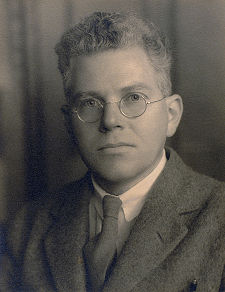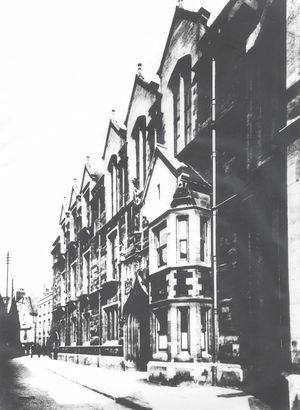Mark Oliphant
- Birthdate
- 1901/10/08
- Death date
- 2000/07/14
- Fields of study
- Nuclear physics
Biography
Sir Marcus 'Mark' Laurence Elwin Oliphant AC, KBE was an Australian physicist and humanitarian who played a fundamental role in the first experimental demonstration of nuclear fusion and the development of the atomic bomb.
During retirement he was appointed state governor of South Australia. He assisted in the inauguration of the Australian Democrats and chaired the 1977 Melbourne meeting at which the party was launched.
In 1925, he heard a speech given by New Zealand physicist Ernest Rutherford and decided then and there that he would work for him—an ambition he fulfilled by gaining a position at the Cavendish Laboratory at the University of Cambridge in 1927 which was at the time carrying out the most advanced research into nuclear physics in the world. It was at the Cavendish, for example, that the atom was first split in 1932. Amongst other research, Oliphant worked on the artificial disintegration of the atomic nucleus and positive ions, and he designed complex particle accelerators.
Oliphant's contribution to this work was his discovery of the nuclei of helium 3 (helions) and tritium (tritons). He was also the first to discover heavy hydrogen nuclei could be made to react with each other (tritons and helions being the products, along with protons and neutrons). This fusion reaction is the basis of a hydrogen bomb and fusion power reactors. Ten years later, American scientist Edward Teller would press to use Oliphant's discovery in order to build one. However, Oliphant did not foresee this: "we had no idea whatever that this would one day be applied to make hydrogen bombs. Our curiosity was just curiosity about the structure of the nucleus of the atom, and the discovery of these reactions was purely, as the Americans would put it, coincidental."
In 1937, Oliphant was appointed professor of physics at the University of Birmingham. While visiting prototype radar stations, he realized that a shorter wavelength was needed urgently. In 1939, he obtained a grant from the British Admiralty to develop radar with a wavelength less than 10 centimetres, compared to the best available at the time of 150 cm.
In 1939, he also visited Berkeley, California, where he met Ernest Lawrence, who gave him a complete set of specifications for his 60-inch cyclotron at Birmingham, but the war prevented this from being completed until 1950.
Role in airborne radar development
Oliphant's group at Birmingham included John Randall and Harry Boot who developed the resonant-cavity magnetron in 1940, achieving the wavelengths needed for an airborne radar. The magnetron's power was soon increased 100-fold, and Birmingham concentrated on magnetron development. The first operational magnetrons were delivered in August 1941. This invention was one of the key scientific breakthroughs during the war and played a major part in defeating the German U-boats, intercepting enemy bombers and in directing Allied bombers. See also Tizard Mission.
Role in atomic bomb development
Also at Birmingham, in 1940, Otto Frisch and Rudolf Peierls had calculated that a uranium-235 atomic bomb was feasible. Oliphant took their findings at once to higher authority. A committee, code-named Maud, sent the report to the US "Uranium Committee" around March 1941 but the Americans took no action.
Britain was at war and felt an atomic bomb was urgent; there was less urgency in the USA. Mark Oliphant was one of the people who pushed the American programme into action. Oliphant flew to the United States in late August 1941 in an unheated bomber, ostensibly to discuss the radar programme but was actually tasked to find out why the United States was ignoring the Maud Committee's findings. Oliphant said that "the minutes and reports had been sent to Lyman Briggs, who was the Director of the Uranium Committee, and we were puzzled to receive virtually no comment. I called on Briggs in Washington, only to find out that this inarticulate and unimpressive man had put the reports in his safe and had not shown them to members of his committee. I was amazed and distressed."
Oliphant then met with the Uranium Committee. Samuel K. Allison was a new committee member, a talented experimentalist and a protege of Arthur Compton at the University of Chicago. Oliphant "came to a meeting," Allison recalls, "and said 'bomb' in no uncertain terms. He told us we must concentrate every effort on the bomb and said we had no right to work on power plants or anything but the bomb. The bomb would cost 25 million dollars, he said, and Britain did not have the money or the manpower, so it was up to us." Allison was surprised that Briggs had kept the committee in the dark.
Oliphant then visited his friends Ernest Lawrence, James Conant and Enrico Fermi to explain the urgency. Lawrence then also contacted Conant and Arthur Compton. On July 1, 1941 Vannevar Bush, chairman of the National Defense Research Committee, created the larger and more powerful Office of Scientific Research and Development (OSRD) which was empowered to engage in large engineering projects in addition to research. The Uranium Committee became the S-1 Project of the OSRD and in December 1941, following the attack on Pearl Harbor, the Manhattan Engineering District was built, and the project was dubbed the Manhattan Project.
In November 1943, Oliphant moved to work on the Manhattan Project as part of the British delegation. The work on the bomb made him uneasy and he preferred to concentrate on processes for refining uranium-235 at Berkeley with his friend Ernest Lawrence - a vital but less overtly military part of the project. He was awarded the 1943 Hughes Medal.
He returned to England in April 1945 and, after VE-Day, resumed his post as professor of physics at the University of Birmingham. It was here that he first heard of the use of the atomic bomb on Hiroshima. He was later to remark that he felt "sort of proud that the bomb had worked, and absolutely appalled at what it had done to human beings." He became a harsh critic of nuclear weapons and a member of the Pugwash Conferences on Science and World Affairs. ". . . I, right from the beginning, have been terribly worried by the existence of nuclear weapons and very much against their use." His wartime work would have earned him a Congressional Medal of Freedom with Gold Palm, but the Australian government vetoed the honor.
Later years in Australia
In 1950, Oliphant returned to Australia as first director of the Research School of Physical Sciences at the new Australian National University, where he initiated the design and construction of the world's largest (500MJ) homopolar generator. This machine was used to power the large-scale railgun which was used as a scientific instrument. He established the Australian Academy of Science in 1954 and was its first president until 1956. After retiring from the university in 1967, Oliphant was invited to become state governor of South Australia, a position he held from 1971 to 1976. During his period he caused great concern to premier Don Dunstan when he strongly supported the decision of the governor-general, Sir John Kerr in the 1975 Australian constitutional crisis. Oliphant was knighted in 1959 and was made a Companion in the Order of Australia (AC) in 1977.
Late in life he watched his wife, Rosa, suffer before her death in 1987 and became an advocate for voluntary euthanasia.
On July 14, 2000, Oliphant died in Canberra, aged 98.

